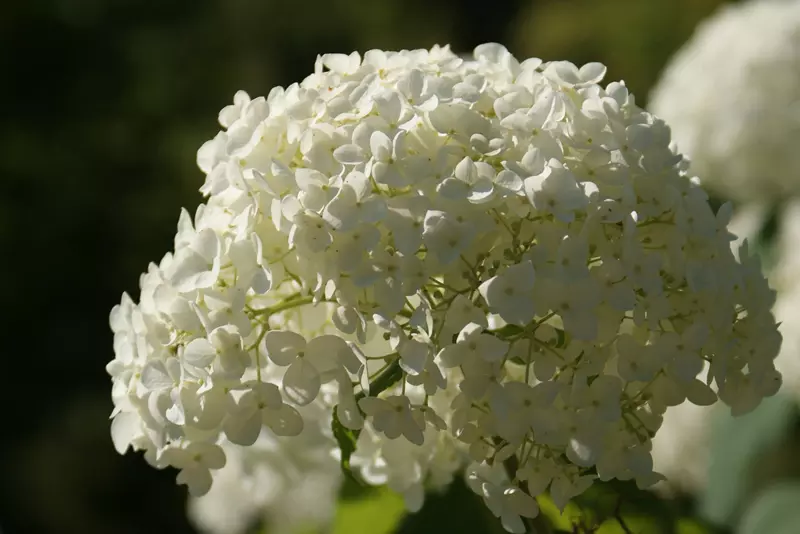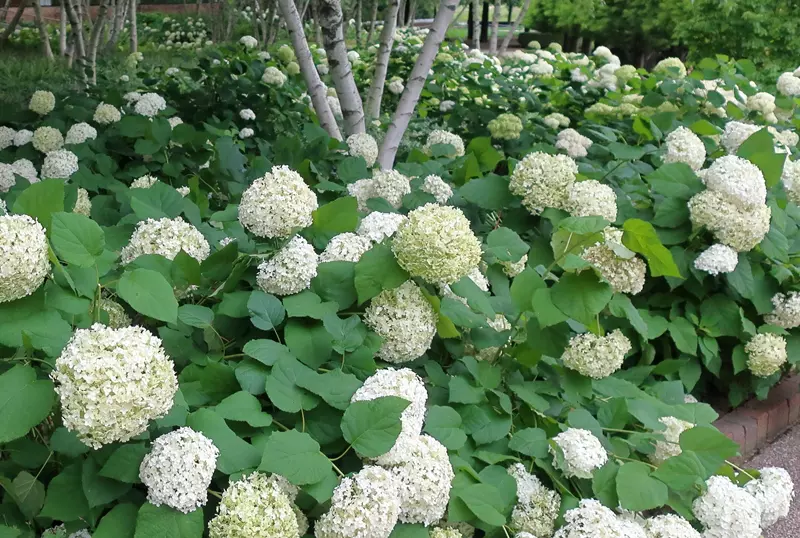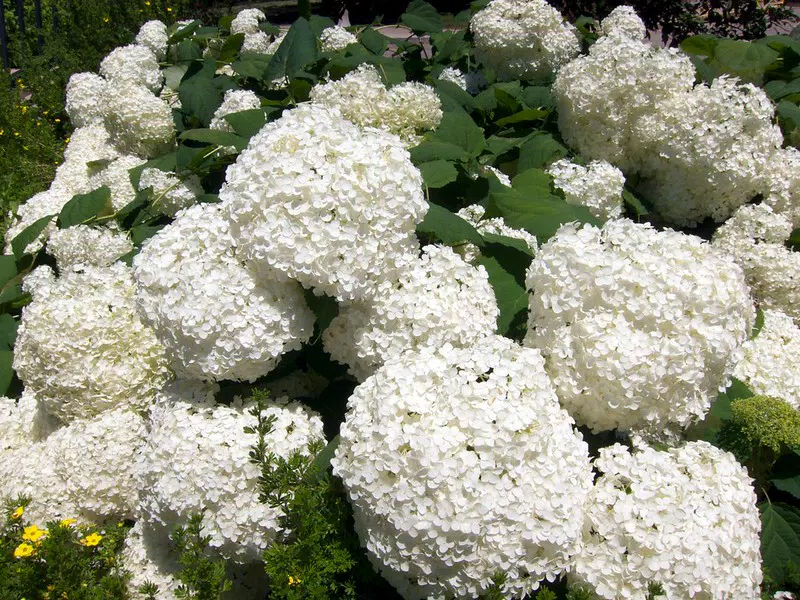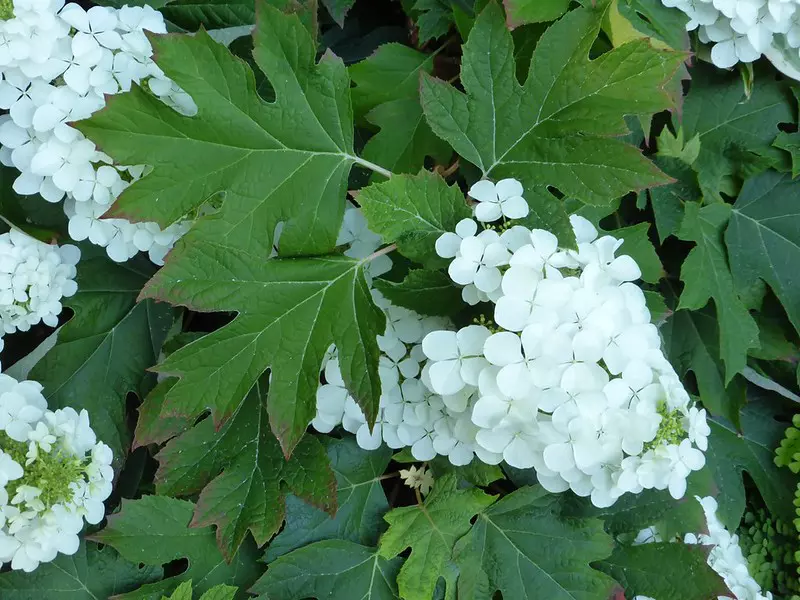
The Ultimate Guide to Hydrangea arborescens (Smooth hydrangea or Sevenbark)
A complete guide to Hydrangea arborescens, including planting, pruning, soil adjustments, eco-friendly pest management, propagation, and garden design ideas.
Read MoreHydrangea arborescens 'Annabelle', commonly known as 'Annabelle' hydrangea, is a deciduous shrub renowned for its large, spherical clusters of white flowers. Blooming from early summer, these impressive flower heads can reach up to 25 cm in diameter, creating a stunning display in gardens. The plant typically grows to a height and spread of 1.5 to 2.5 metres, forming a rounded, bushy shape. Its broadly oval, dark green leaves provide an attractive backdrop to the luminous blooms.
Hydrangea arborescens 'Annabelle' is a popular choice among gardeners, but it's essential to weigh its advantages and disadvantages before adding it to your landscape.

'Annabelle' hydrangeas are highly adaptable and can thrive in a variety of garden styles and layouts. Here are the types of gardens where this plant truly shines:
Choosing 'Annabelle' depends on your gardening goals and preferences. This variety is particularly suitable for:
There are many reasons why 'Annabelle' is a popular choice among gardeners. Here are its key advantages:
Despite its many benefits, 'Annabelle' may not be the perfect fit for every garden. Consider these potential drawbacks:
Hydrangea arborescens 'Annabelle' is a versatile and visually stunning shrub that fits beautifully into various garden styles. Its low-maintenance nature and striking blooms make it an excellent choice for both novice and experienced gardeners. However, it’s essential to consider factors such as water availability, desired colour variety, and potential stem support needs before planting.
If you’re looking for a plant that combines elegance with ease of care, 'Annabelle' is likely the right choice for you. Whether as a focal point, a border plant, or part of a woodland setting, it’s a reliable and rewarding addition to any garden.
Proper planting is crucial to ensure its healthy growth and prolific flowering. This guide provides detailed instructions to help you plant 'Annabelle' hydrangeas successfully.
For the best establishment, plant 'Annabelle' hydrangeas during the cooler periods of the year:
Choosing the right location is vital for the health of your 'Annabelle' hydrangea:
Before planting, it's essential to prepare the hydrangea properly:
Follow these steps to plant your 'Annabelle' hydrangea:
To support the establishment of your 'Annabelle' hydrangea:
By adhering to these guidelines, your Hydrangea arborescens 'Annabelle' will be well-positioned to flourish, offering beautiful blooms and enhancing your garden's aesthetic appeal.
'Annabelle' hydrangeas flourish in partial shade, ideally receiving morning sunlight followed by afternoon shade. In cooler climates, they can tolerate full sun, provided the soil remains consistently moist to prevent wilting.
These hydrangeas prefer moist but well-drained soils rich in organic matter. Incorporating compost or well-rotted manure can enhance soil fertility and structure. While they can adapt to various soil types, improving chalky soils with organic matter supports optimal growth.
Maintaining consistent soil moisture is crucial, especially during dry periods. Water deeply once or twice a week, ensuring the soil remains moist but not waterlogged. Applying a layer of mulch around the base helps retain moisture and regulate soil temperature.
In early spring, apply a balanced, slow-release fertiliser to promote healthy growth and abundant flowering. Avoid excessive fertilisation, as it can lead to lush foliage at the expense of blooms.
'Annabelle' blooms on new wood, making it suitable for annual pruning. In late winter or early spring, prune back stems to a framework of branches to encourage vigorous growth and larger flower heads. Removing up to one-third of the oldest stems at the base can help maintain a compact and bushy shape.
While generally resilient, 'Annabelle' hydrangeas can be susceptible to pests like aphids, capsid bugs, hydrangea scale, and vine weevils. Regular monitoring and the use of appropriate treatments can help manage these issues. Additionally, they may face diseases such as leaf spot, powdery mildew, grey mould (Botrytis), and, rarely, honey fungus. Ensuring good air circulation and avoiding overhead watering can reduce disease incidence.
'Annabelle' hydrangeas are hardy and can withstand cold temperatures. However, applying a mulch layer in late autumn can protect the root system from severe frost and help retain soil moisture during winter.
By adhering to these care guidelines, your Hydrangea arborescens 'Annabelle' will reward you with magnificent blooms and robust growth, enhancing the beauty of your garden.
Contrary to some beliefs, the ideal time to prune 'Annabelle' hydrangeas is in early spring, around March, after the risk of frost has passed. Pruning in autumn is discouraged, as it can leave the plant vulnerable to frost damage during winter. By retaining the old growth through winter, the plant has a buffer against potential frost damage, allowing it to "die back" naturally if necessary.
To promote vigorous growth and prolific flowering:
When pruning 'Annabelle' hydrangeas:
By adhering to these pruning guidelines, your Hydrangea arborescens 'Annabelle' will thrive, providing stunning floral displays and enhancing your garden's beauty.
Softwood cuttings are taken from the current season's fresh, green growth. This method is effective and commonly used for 'Annabelle' hydrangeas.
Late spring to early summer is ideal for taking softwood cuttings, as the new growth is still pliable and has not yet hardened.
Maintain temperatures between 18-24°C (65-75°F) and provide bright, indirect light. Roots typically develop within 2-3 weeks.
Hardwood cuttings are taken from mature, woody stems during the plant's dormant period.
Late autumn to early winter, when the plant is dormant, is the best time for hardwood cuttings.
Place the cuttings in a sheltered location with temperatures between 4-10°C (40-50°F). Root development may take several months, with new growth appearing in spring.
Division involves separating an established plant into multiple sections, each with its own root system.
Early spring or late autumn, when the plant is dormant, is ideal for division.
Mulch around the base to retain moisture and regulate soil temperature. Keep the soil consistently moist as the divisions establish.
Propagating Hydrangea arborescens 'Annabelle' through softwood cuttings, hardwood cuttings, or division can be rewarding. Each method has its advantages, and choosing the appropriate one depends on the time of year and available resources. With proper technique and care, you can successfully propagate this beautiful hydrangea.
'Annabelle' hydrangeas may encounter several pests. Adopting natural control methods can effectively manage these issues.
These small, sap-sucking insects can cause distorted growth and excrete honeydew, leading to sooty mould.
Capsid bugs can cause small, irregular holes in leaves and distorted growth.
Scale insects appear as white, oval spots on stems and leaves, leading to weakened plants.
Vine weevil larvae feed on roots, causing wilting, while adults notch leaf edges.
Implementing cultural practices can minimise disease incidence in 'Annabelle' hydrangeas.
Fungal leaf spots cause brown or purplish lesions on foliage.
This fungal disease presents as a white, powdery coating on leaves.
Grey mould causes fuzzy, grey spores on flowers and leaves, especially in damp conditions.
Although rare, honey fungus can cause root rot and plant decline.
By employing these environmentally friendly strategies, you can effectively manage pests and diseases affecting Hydrangea arborescens 'Annabelle', ensuring a healthy, vibrant garden that supports pollinators and beneficial organisms.
Issue: During hot summer days, 'Annabelle' hydrangeas may exhibit wilting, especially when exposed to prolonged direct sunlight.
Solution: Ensure the plant receives sufficient water during hot spells. Mulching around the base helps retain soil moisture. Providing afternoon shade can also protect the plant from intense sunlight.
Issue: Susceptibility to fungal diseases, such as powdery mildew, particularly in humid conditions.
Solution: Plant hydrangeas in well-ventilated areas to promote air circulation. Avoid overhead watering to reduce humidity around the plant. Fungicidal treatments can be applied preventively or at the first signs of infection.
Issue: Pests like aphids and spider mites may target 'Annabelle' hydrangeas, leading to distorted growth and reduced vigour.
Solution: Regularly inspect the plant for signs of infestation. Insecticidal soaps or neem oil can control pests. Introducing natural predators, such as ladybirds, can also help manage pest populations.
Issue: Blooms may turn brown prematurely, affecting the plant's aesthetic appeal.
Solution: Regular watering during dry periods can mitigate this issue. Providing some shade during the hottest part of the day can help preserve bloom quality.
Issue: Overly large flower heads can cause stems to droop.
Solution: Pruning and providing proper support can help maintain an upright growth habit.
Issue: Improper pruning or poor soil conditions can lead to a lack of blooms.
Solution: Ensure correct pruning practices and maintain soil health to encourage flowering.
Issue: Leaves turning brown or yellow due to excessive sunlight or inadequate watering.
Solution: Provide adequate water and consider planting in a location with partial shade to prevent leaf scorch.
By identifying and addressing these common issues, you can ensure that your Hydrangea arborescens 'Annabelle' remains healthy and continues to enhance your garden with its beautiful blooms.
'Annabelle' hydrangeas are adaptable and can be utilised in multiple landscape settings:
Pairing 'Annabelle' hydrangeas with suitable companion plants can enhance garden aesthetics and promote a healthy ecosystem. Consider the following companions:
Thriving in similar moisture and light conditions, Astilbe offers feathery plumes in shades of pink, red, and white, complementing the hydrangea's blooms and adding textural contrast.
Hostas provide lush, broad foliage that contrasts beautifully with 'Annabelle's' flowers. Their preference for partial shade and moist soil aligns well with hydrangeas, creating a harmonious planting scheme.
Ferns add delicate, airy foliage that complements the boldness of hydrangea blooms. They thrive in shaded, moist environments, making them ideal companions.
With vibrant, trumpet-shaped flowers, daylilies bloom around the same time as 'Annabelle', providing a colourful contrast. They are hardy and adaptable, suitable for similar growing conditions.
Heuchera offers colourful foliage ranging from deep purples to bright greens, adding year-round interest. Their small, bell-shaped flowers attract pollinators, supporting garden biodiversity.
When integrating 'Annabelle' hydrangeas into your landscape:
By thoughtfully incorporating 'Annabelle' hydrangeas and their companion plants into your garden design, you can create a cohesive and vibrant landscape that offers continuous interest and supports a healthy ecosystem.
Yes, 'Annabelle' hydrangeas can grow in full sun, but they perform best in partial shade. In hot climates, prolonged exposure to intense sunlight may cause stress and wilting. If planting in full sun, ensure the soil remains consistently moist and consider adding mulch to retain soil moisture and regulate temperature.
'Annabelle' hydrangeas thrive in consistently moist soil. Water deeply once or twice a week, depending on weather conditions, to ensure the roots receive adequate hydration. During hot or dry spells, increase the frequency to prevent the plant from wilting. Avoid waterlogging, which can lead to root rot.
Prune 'Annabelle' hydrangeas in late winter or early spring, before new growth begins. Focus on removing dead or weak stems and cutting back old growth to about 10-20cm (4-8 inches) above the ground. This encourages vigorous new growth and larger blooms during the growing season.
No, 'Annabelle' hydrangeas are not deer-resistant and can be browsed by deer, especially during periods when other food sources are scarce. To protect your plants, consider using natural deterrents, such as planting deer-resistant companions nearby, applying deer repellent sprays, or installing fencing.
Yes, 'Annabelle' hydrangeas can be grown in containers, but it is essential to use a large pot with adequate drainage. Choose a high-quality, well-draining potting mix and water regularly, as container plants tend to dry out faster. Re-pot every 2-3 years to refresh the soil and accommodate growth.
Yes, the large blooms of 'Annabelle' hydrangeas are attractive to bees and butterflies, making them a great addition to pollinator-friendly gardens. Their flowers provide a valuable nectar source, particularly in mid to late summer when other blooms may be scarce.
To achieve larger blooms, apply a balanced, slow-release fertiliser in early spring. Pruning in late winter helps redirect the plant's energy into producing strong new growth and larger flower heads. Ensuring consistent watering and mulching also supports bloom development.
Yes, 'Annabelle' hydrangeas are hardy in USDA zones 3-9 and can tolerate frost. During particularly harsh winters, some stems may die back, but the plant typically regrows vigorously in spring. Adding a layer of mulch in late autumn can protect the root zone from extreme cold.
'Annabelle' hydrangeas prefer moist, well-draining soil with a neutral to slightly acidic pH (around 6.0-7.0). Adding organic matter, such as compost or leaf mould, improves soil structure and nutrient content, creating an optimal environment for healthy growth.
The showy blooms of 'Annabelle' hydrangeas can last from early summer until late autumn. The flowers start as bright white and gradually fade to a soft green as the season progresses, adding visual interest to the garden for several months.

A complete guide to Hydrangea arborescens, including planting, pruning, soil adjustments, eco-friendly pest management, propagation, and garden design ideas.
Read More
Discover the top 10 most popular hydrangea varieties in the UK, their unique characteristics, and tips for incorporating them into your garden.
Read More
A complete guide to Hydrangea quercifolia, including planting, pruning, soil adjustments, eco-friendly pest management, propagation, and garden design ideas.
Read More